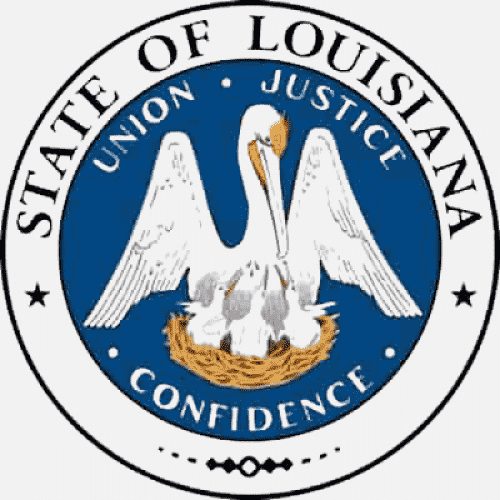 State Flag |  State Seal |
Louisiana is a state located in the southern region of the United States. It is bordered to the west by Texas; to the north by Arkansas; to the east by the state of Mississippi; and to the south by the Gulf of Mexico.
- ABBREVIATION: LA
- NICKNAME: The Pelican State
- POPULATION: 4,597,740 (2024 est.)
- CAPITAL: Baton Rouge
- STATE BIRD: Eastern Brown Pelican
- STATE FLOWER: Magnolia
- AREA: 51,843 sq. mi.
- TIME ZONE: Central
- ENTERED UNION: Apr. 30, 1812
- ALTITUDE: High, 535 ft. Driskill Mountain
- CLIMATE: Humid. Long hot summers, short mild winters. Moderately heavy rainfall.
Shaped like a swashbuckler’s boot, with a toe dipping into the Gulf of Mexico, Louisiana lies on a low coastal plain. Jean Lafitte found its coast a fine place from which to practice piracy in the 19th century.
In the inland bayou region, “a maze of sluggish and devious waters” darkened by moss-draped cypress forests, the Acadian settlers of Longfellow’s Evangeline lived in an easy-going prosperity based on rich crops and cattle raising. Their descendants, the “Cajuns” are still there.
Thanks to the Bayou country, Louisiana
leads the nation in wild muskrat and nutria trapping. The State is also first in shrimp fishing and sugar cane production and among the top three states in rice production. To the north the waterways are less kind, ceaselessly eroding the soil of the rolling “piney woods”.
But to the east, water has been benign, laying down a ribbon of exceptional fertility along the banks of the Mississippi. Here early planters turned the land into an Eden of cotton and cane.

New Orleans’ Central Business District
Louisiana is often affected by tropical cyclones and is very vulnerable to strikes by major hurricanes, particularly the lowlands around and in the New Orleans area. In 2005 Hurricane Katrina made land in Louisiana, devastating the city of New Orleans and the surrounding area. It is the costliest natural disaster, as well as one of the five deadliest hurricanes, in the history of the United States.
Fun Facts:
- Louisiana is the only state in the Union that has parishes instead of counties, and that refers to the Napoleonic Code in its laws.
- Up until 2010 the 24-mile long Lake Pontchartrain Causeway was the longest bridge completely over water in the world. (In July 2011 the Jiaozhou Bay Bridge in China was named by Guinness as the ‘longest bridge over water’.)
- Mardi Gras colors are Purple (Justice), Gold (Power), and Green (Faith).
- Because of its low water table, New Orleans has many cemeteries with above-ground tombs. They are known as cities-of-the-dead because the rows of tombs resemble city streets.
- Louisiana’s Creole society is made up of descendants of people of Spanish or French heritage mixed with that of African slaves who gained freedom before the Civil War.
- Gueydan is known as the “Duck Capital of America” in recognition of its abundance of waterfowl.
History:
Louisiana’s history is one of rich cultural fusion, colonial power struggles, and economic transformation. Located at the mouth of the Mississippi River, Louisiana has long served as a crossroads for Native American tribes, European empires, enslaved Africans, and diverse immigrant groups. Its story is central to the development of the American South.
Before European contact, Louisiana was inhabited by many Native American peoples, including the Caddo, Chitimacha, Tunica, and Natchez. These groups built complex societies, traded with neighboring tribes, and lived along the state’s rivers and bayous. Their knowledge of the land would later influence French and Spanish settlers.
In 1682, French explorer Robert de La Salle claimed the vast Mississippi River basin for France, naming it “Louisiana” in honor of King Louis XIV. In 1718, the French established New Orleans, which quickly became a strategic port and cultural hub. Louisiana was a part of the French colonial empire until 1763, when France ceded it to Spain after the Seven Years’ War. Spain governed the territory until 1800, when it was briefly returned to France.
In 1803, the United States purchased the Louisiana Territory from France in the Louisiana Purchase, doubling the size of the young nation. This acquisition included all or part of 15 modern U.S. states. Louisiana became the 18th U.S. state on April 30, 1812.
From its beginnings, Louisiana’s culture was shaped by its French, Spanish, African, and Caribbean influences. The state developed a unique Creole and Cajun identity, marked by distinct language, cuisine, music, and religious practices. French and Spanish colonial laws, Catholicism, and Afro-Caribbean traditions combined to create a society unlike any other in the United States.
Slavery played a central role in Louisiana’s economy, particularly on sugar and cotton plantations. Enslaved Africans brought to the region contributed not only to its agricultural success but also to its cultural life. The port of New Orleans became one of the largest centers of slave trade in the country.
During the Civil War, Louisiana joined the Confederacy, and New Orleans was a key target for Union forces. In 1862, the city was captured by Union General Benjamin Butler, making it one of the first major Southern cities to fall.
After the war, Louisiana went through Reconstruction, facing economic hardship, political violence, and the imposition of Jim Crow laws that disenfranchised African Americans.
In the 20th century, Louisiana modernized its economy with the rise of the oil and gas industries. While agriculture remained important, the discovery of offshore oil reshaped the state’s economy. At the same time, New Orleans remained a national cultural treasure, known for its jazz music, Mardi Gras celebrations, and French Quarter architecture.
Today, Louisiana continues to balance its unique heritage with modern challenges, including hurricanes, environmental issues, and economic inequality. From Native traditions to European colonization, from slavery and civil war to modern culture and industry, Louisiana’s history is as vibrant and diverse as its people.